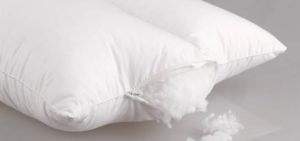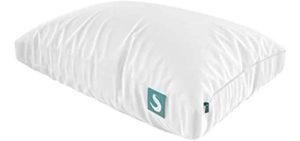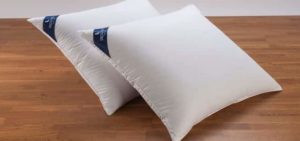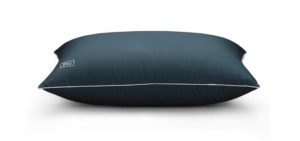Replacing Your Pillow often or as required is not just about hygiene but also the pillow’s functionality.
After a few years, many pillows still need to offer the support and comfort they initially delivered and need replacement.
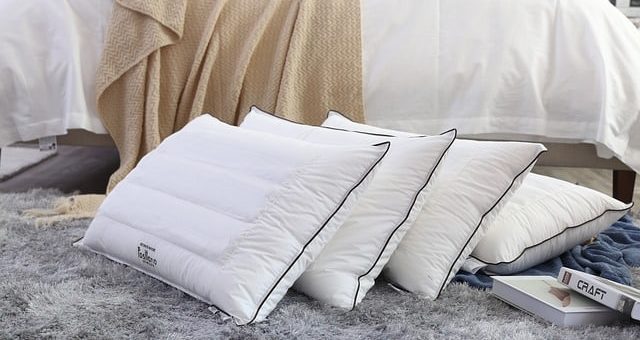
Table of Contents
Why is it Important to Replace Your Pillow
- Hyggiene – Every night you sleep on your pillow, your body sheds skin, you sweat, and body oils stick to your pillow. That worsens for people who sweat excessively or have very oily-prone skin and hair. Eventually, this soaks into your pillow, giving it a bad odor and a breeding ground for bacteria.
- Support – The weight of your head, neck, and shoulder bear on your pillow every night. After a couple of years, your pillow may lose its loft and support functions and will wear out in certain areas.
- Dust Mites – Whether you believe it or not, Dust Mites are a reality. And a pillow soaked in body oils and skin cells is the ideal breeding ground for these creatures to collect in. All in all, Dust Mites, in turn, aggravate allergies.
- Dust and Allergens – Over the years, dust and other allergens can collect inside your pillow, making it more hazardous to your health. These particles can cause snoring, difficulty breathing, and allergies.
As you can see, replacing your pillow is necessary, so when should you consider replacing your Pillow?

- When your pillow has noticeable lums and empty sports.
- When there are permanent stains, or it becomes yellow.
- When you wake up with aches and pains, that is not a problem.
- If you suddenly start suffering from unexplainable tension headaches.
- When you start developing skin allergies or sneeze, have a runny nose and watery eyes.
- When you have a feather or down pillow and fold it in half, it should expand and not stay that way.
- When you have switched sleeping positions and need different support.
- If you are allergic to your pillow.
When Should Your Replace Your Pillows
The rule of thumb is to replace your pillows every 1 to two years, although certain pillow types and fils last longer, which will also depend mainly on the quality and construction of the pillow.
- Latex Filled Pillows – A latex-filled pillow only needs replacing every 3-4 years, as latex is a firm and durable natural material.
- Buckwheat Fill Pillows – Buckwheat-filled pillows need replacing every three years or if the buckwheat accidentally becomes wet.
- Feather Pillows – Most Feather and Down Pillows last 18-36 months before needing replacement as it s an animal-derived fill.
- Memory Foam Pillows – Memory foam loses its shape and support capabilities after 18-36 months.
- Down Fill Pillows – Down can last up to two years.
- Down Alternative Synthetic Fill Pillow – This synthetic pillow lasts 18 to 24 months before losing shape.
- Polyester Fill – The Polyester pillow is a synthetic-filled pillow that does not last very long, only 6-24 months, depending on the quality and construction.
How to Wash and Maintain your Pillow
Washing Your Pillow
You can keep your pillow much more hygenic by washing it regularly, which can remove excess oils, odors, sweat, and stains and even rid you of those pesky dust mites and other allergens.
However, there is a particular washing method for every pillow type and fill, so it is essential to follow the instructions on the labels of your pillow closely.
You should never wash buckwheat pillows, as the Buckwheat husks will mold and become soggy if they get wet. Feather pillows and down pillows need special care when washed.
You should also wash memory foam and latex with care. Most cotton, down alternative, and polyester-filled pillows are machine washable and can be dried in a tumble dry.
Using Pillow Covers
Investing in a proper waterproof pillow cover is one of the best ways to lengthen the life of and maintain your pillow.
This cover prevents any liquids and dust particles, skin cells, or dust mites from entering your pillow and will preserve and protect it for a very long time. You can wash the cover regularly without hassle, and are protected against spills.
However, the cover won’t help maintain the support and loft of your pillow so you will need a replacement.
How to Find The Best Pillow Replacement
So You have decided to finally take the leap and make the much-dreaded replacement of your favorite pillow.
Here are a few things to consider before choosing your next pillow;

- Fill and Fiber – Consider the Fill of the Pillow and the Fiber used in the casing or cover. For the cover, cotton and bamboo are two great options. For the fill, you need to consider the support that you need. Latex and memory foam offer firmer and more moldable support; choose gel-infused memory foam for the cooling effect. Shredded latex or Memory foam is my favorites as they are also more adjustable. Down and feather is ideal if you like a soft, plush, low-profile pillow and is perfect for stomach sleepers. If you have allergies, then opt for a Down and Feather alternative. Other less popular fills are Microbeads, Polyester, and cotton, which tend to lose their shape easily and are a medium to soft support; then there is also wool, which is quite expensive, plush, and long-lasting. Buckwheat, however, will give you a hard and firm, supportive pillow.
- Fill Weight – The weight and loft of the fill is also important. While memory foam and latex are firmer and heavier, a lighter fill such as polyester or down is much more fluffy, light, and easy to move around.
- Quality of The Fill – Investing in quality, looking for reputable brands, and ethically sourced and certified fill materials is important.
- Pillow Size – Today, there are many size options besides the standard or continental-sized pillows; you can go for a Large Queen size or much larger King sied options. You can also opt for different-shaped pillows such as a wedge or neck pillow or even a full body pillow for other support functions.
- Your Sleeping Position – This is important as some pillow types offer better support for certain sleeping positions. SIDE SLEEPERS need a thicker and firmer pillow, while BACK SLEEPERS need a flatter and softer pillow, and STOMACH SLEEPERS will require a very low profile and soft pillow or no pillow at all.
To Conclude
As you can see, you need to replace your pillow mainly for HYGENIC and SUPPORT reasons. Also, every pillow fill type has a different lifespan, so knowing your particular type and fill is important.
Then again, there are a few considerations to take when choosing a new pillow that will last and provide you with the support you need for your specific sleeping position requirements.

